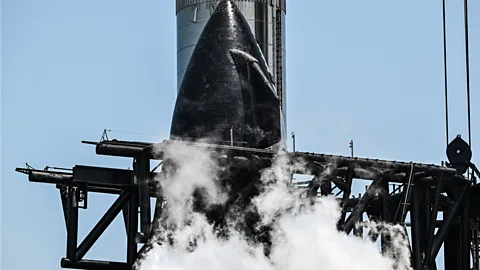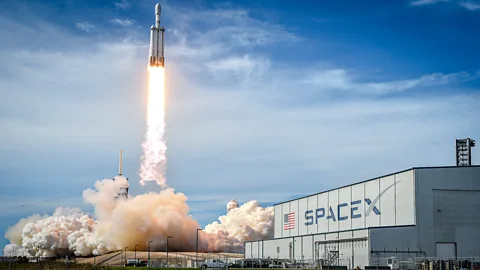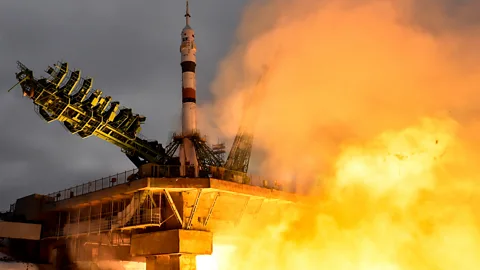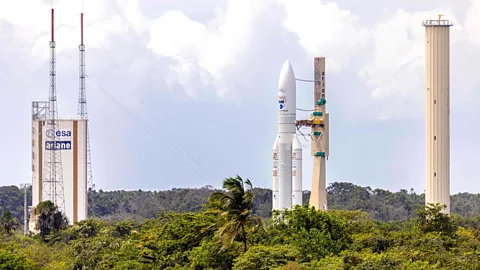When rockets go wrong – protecting the environment from catastrophe

 Getty Images
Getty ImagesSpace launches are increasing and the rockets are getting bigger. What's the environmental impact on the surrounding areas, particularly when things go wrong?
When SpaceX's Starship slowly hauled itself off the launchpad and into the Texas skies on 20 April 2023, few people expected the maiden flight of the world's most powerful rocket to last as long as it did.
Applause broke out among the crowds lining nearby roads as Starship cleared the tower and its 33 engines blasted it into a cloudless sky. Then – three minutes and 57 seconds into its planned 90-minute flight – the spacecraft exploded, plunging back into the sea in a rain of debris. Engineers at SpaceX described the explosion as "a rapid unscheduled disassembly"; SpaceX owner Elon Musk said it was "exciting". The mission was declared a success.
It was certainly exciting and, from an engineering perspective, most definitely a success. Starship pushes the boundaries of rocket technology and, after its latest June 2024 flight, the spacecraft is considered by some to be well on its way to becoming a viable means of sending satellites, and one day people, into orbit and beyond to the Moon. But once the live coverage of the first flight had ended, engineers made a shocking discovery: the launch had not only destroyed the launcher but also the launchpad itself.
SpaceX's launch site at Boca Chica is on the southern border of the United States, overlooking the Gulf of Mexico. The company launches to the east to gain the benefit of the Earth's rotation, with the added advantage that any rocket debris falls into the ocean (though what effect these rocket crashes have on the marine environment are largely unknown). The area is surrounded by state parks and national wildlife refuge lands – an important area for protected plants and migratory birds.
 Getty Images
Getty ImagesWhen the engines on the launcher ignited, the pad was enveloped in a cloud of dust and smoke. This concealed an explosive plume of debris – the rocket burned a crater in the structure and sent sand, soil, chunks of metal and concrete flying through the air to land up to 10km (6.2 miles) away.
Fortunately, no-one was injured but remote cameras captured some of the damage, local public radio reported "ash" falling on nearby communities and, later, that the surrounding conservation areas were strewn with wreckage. The fallout was officially documented by the government's US Fish and Wildlife Service and Starship was grounded.
Before the launch, SpaceX had agreed to adhere to tight environmental conditions and had tested the launch pad with the rocket bolted down and the engines fired, but not at full thrust. In a post on X after the launch, Musk admitted that a "massive water-cooled steel plate" intended to go under the rocket at lift-off was not ready in time.
The company has since rebuilt the launchpad to an improved design. But the explosion highlighted what appears to be a growing concern among environmental groups. With the number of objects launched into space growing every year – now reaching into the thousands – and with new launchers being developed, many environmental organisations are concerned about the unintended impact of rocket technology. Particularly when things go wrong.
"It's hard to watch these huge explosions," says Sarah Gaines Barmeyer, deputy vice president of conservation programmes at the National Parks Conservation Association (NPCA) in the US. "The amount of environmental destruction they cause with the debris, and the potential for fires, air and water pollution – we would like to see more security and testing before we're launching spaceships near protected areas."
In the aftermath of the explosion at Boca Chica, several conservation groups filed a legal claim against government regulators for allowing the launch. The NPCA, meanwhile, is warning of the wider risk to seashore areas. It is currently campaigning against the development of a commercial launch site on the coast in the state of Georgia near a protected wilderness. The group is also among those concerned about expansion plans at Cape Canaveral in Florida.
 Getty Images
Getty ImagesFamous as the base for Nasa launches, the US Department of the Air Force is currently assessing the environmental impact of building a new launchpad at Cape Canaveral for Starship, and has recently held a series of public meetings in the area to gauge local opinion. One of the proposed sites for the rocket would involve redeveloping an existing launchpad but the other – a potentially more controversial plan – would mean building an entirely new one nearer to the perimeter.
"These places are used to the impacts from the space industry," says Barmeyer. "But what we're seeing right now with new proposals is that they're starting to get closer and closer to protected areas, and that's what we have concerns about."
The cape is surrounded by internationally important plants and wildlife, including the Merritt Island National Wildlife Refuge – one of the most biologically diverse areas in the world.
"[The cape] has approximately 1,133 species of plants, 141 species of fish, 74 amphibians and reptiles, 318 birds and 29 different mammals within its boundaries," says Don Dankert, who heads the environmental management team at Nasa's Kennedy Space Center at Cape Canaveral. "Twenty-one of these species are federally protected, such as manatees, sea turtles and American bald eagles."
Nasa has been monitoring the impacts of launches from the area for more than 40 years, beginning with the early flights of the Space Shuttle. In a statement, Nasa told the BBC that after 135 launches over a 30-year period, the primary impacts were "the accumulation of aluminium particulates, damage to vegetation and temporarily reduced pH in adjacent waters".
Nasa attributes these effects to the propellant burned in the Shuttle's solid rocket boosters, and says similar results were recorded after the November 2022 launch of Artemis (which uses the same solid rocket technology). The agency says it also monitors water, air quality and that the "acute impacts of space shuttle launches to wildlife populations were minimal".
 Getty Images
Getty Images"All vehicles used in Nasa launches are tested extensively before they're allowed to depart," says Dankert. "Part of that process is ensuring that environmental impacts from these launches are minimal and will not cause long-term damage to the ecosystem."
The same cannot be said for the Russian equivalent – the world's first spaceport at Baikonur in Kazakhstan. A cautionary tale of unregulated space ambition, vast areas of the flat steppe have been poisoned by carcinogenic fuel that spilled out of discarded rockets (you can read more about it here).
It could, in fact, be argued that locating the Cape Canaveral launch complex where it is has actually helped to preserve the environment. Much of the nearby Florida coast has been overdeveloped with hotels, restaurants and apartments – the epitome of "paving paradise to put up a parking lot", as Joni Mitchell once sang – but because of security concerns and the risk of explosions, no-one can build too close to the launch site.
Meanwhile, at Kourou in French Guiana, the European Space Agency (Esa) is preparing for the maiden launch of its own giant rocket, Ariane-6 (I wrote about the project here when I visited in 2018). The 650 sq km (251 sq mile) European spaceport is located just north of the equator, and is bordered by mangrove swamps and surrounded by tropical rainforest, home to a rich biodiversity of plants and animals including jaguars – the world's third-largest species of cat and considered a "near threatened" species.
"It's very well preserved," says Luce Fabreguettes, head of infrastructure for Esa's space transport directorate. "[Within the spaceport perimeter] there is no farming, so no chemicals or pesticides, and hunting within the area is banned."
The spaceport is constantly monitored for air, soil and water quality with measures in place around buildings and infrastructure to protect wildlife. A recent solar farm, for instance, has been built with a fence that has holes for frogs to pass through. But, just as with Cape Canaveral, when it comes to the impact of launches, they have also recorded heightened levels of aluminium and acidity from the exhaust of solid rockets.
 Getty Images
Getty Images"There is very little impact, it's very transitory and only extends to around 500m (1,650ft) around the launch site," says Fabreguettes.
The final assembly of the first Ariane 6 is taking place at the launchpad in preparation for a July launch. As Musk will doubtless testify, when it comes to maiden flights, failure is always an option. And veterans of the Esa launch programme will certainly be nervous.
The first Ariane 5 rocket launched in June 1996 lasted just 39 seconds before exploding, the result of a software bug. While expectations remain high for the flight of its successor, mission planners have already worked through worst-cast scenarios. As well as only launching with a wind direction to carry debris out to sea, if the rocket disintegrates, it is designed to come apart in small pieces to minimise damage when they hit the ground.
More like this:
From the first images of our fragile blue green planet from space, to today's satellites that monitor our weather and changing climate, space has transformed our view of the Earth's environment. But unchecked development of spaceports or a rush to develop new launch systems without considering the impact of failure risk undermining that effort.
Barmeyer is, nevertheless, optimistic: "We do really believe that we can find a balance here and that the industry and conservation can exist side-by-side."
--
If you liked this story, sign up for The Essential List newsletter – a handpicked selection of features, videos and can't-miss news, delivered to your inbox twice a week.
